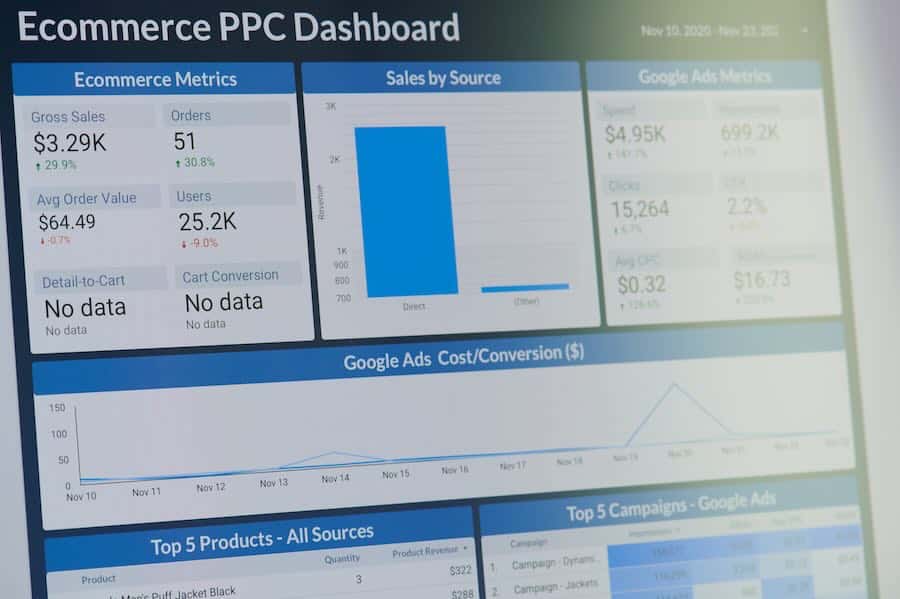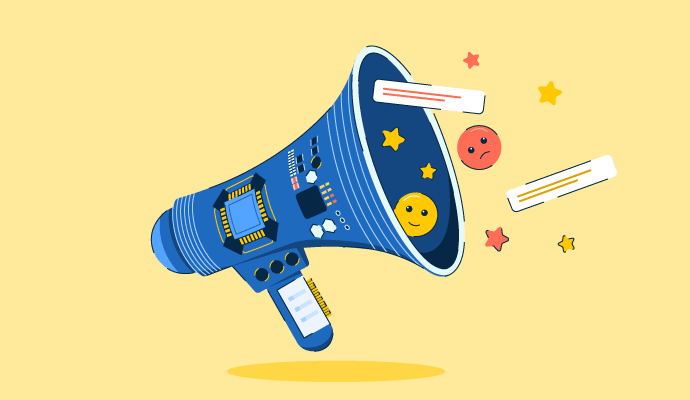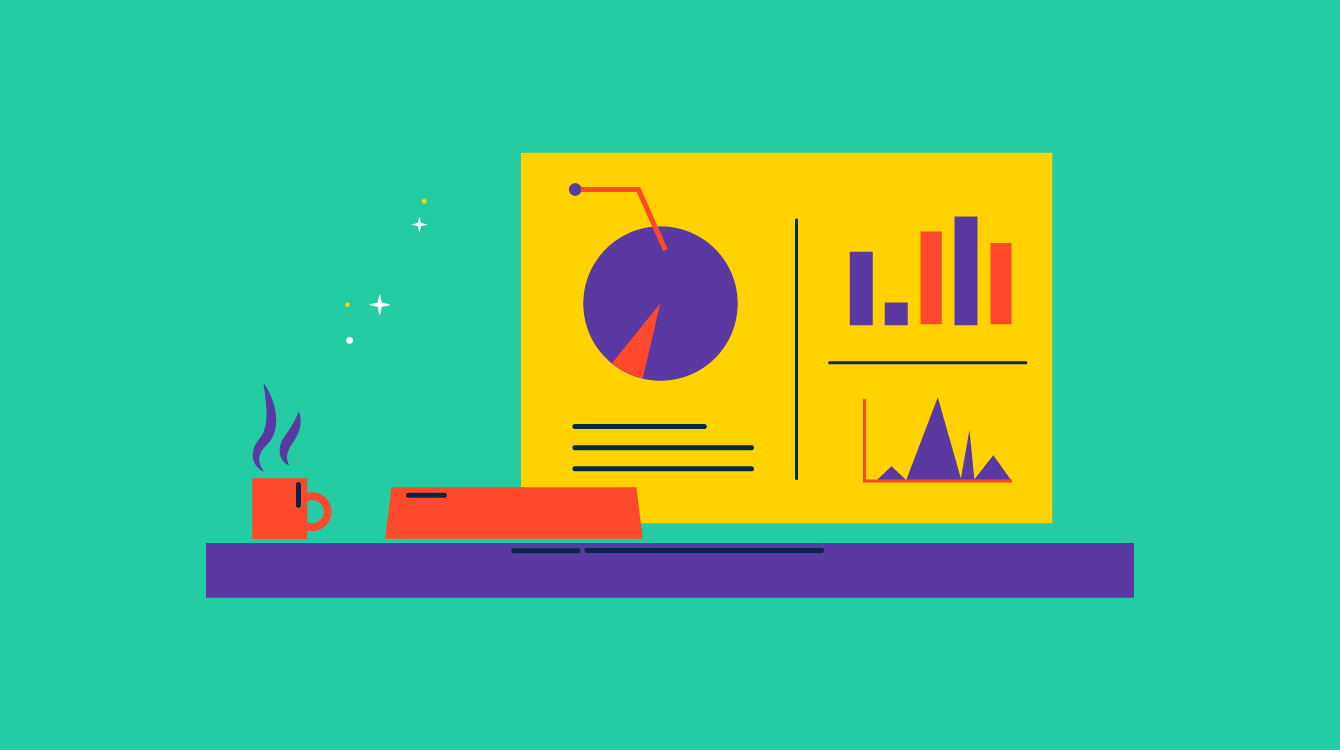
PPC (pay-per-click) advertising can be one of your most useful marketing strategies to grow your small business. It can garner many views, engagements, and conversions, even if you’re short on time or budget. So it’s no wonder it’s one of the most-used marketing tactics for businesses big and small. Take for example these PPC statistics:
Key Takeaways:
- PPC ads aren’t all about awareness—they also have a conversion rate of 2.35%.
- Over 64% of audiences with high purchase intent (aka end-of-funnel audiences) are more likely to click on Google Ads than on organic results.
- Advertising on Bing can let you reach up to 88% of online audiences (you can thank Microsoft’s multiple platforms for that).
- And don’t discount social media: one-quarter of marketers find social media ads are the best for delivering on return on investment (ROI).
There are simply dozens of possibilities in the world of PPC advertising. But to do it effectively, you’ll need the right strategy. Below, we’ve compiled 25 of the most important PPC advertising statistics to help you formulate your PPC strategy, along with the key takeaways to learn from them.
Why PPC Statistics Matter (+ How to Use Them)
Like any marketing tactic, PPC advertising needs careful research and planning to be effective. This is especially true because PPC is so diverse and dynamic as a strategy. PPC strategies on Google have an entirely different set of best practices from Microsoft or TikTok. Plus, with algorithm updates rolling out on these platforms every few months, staying on top of all these new developments is paramount to your ad’s success.
That’s why knowing these PPC advertising statistics is more important than ever. Having hard data to back up your PPC strategies reduces a lot of guesswork, trial-and-error, and wasted ad spend. Here’s how to use the PPC statistics below to best benefit your business’s brand presence:
- To benchmark your PPC ad budget: Setting the right budget for your PPC ads can be tricky. Ideally, you want the least possible spend for the greatest impact. Use the PPC ad budget benchmarks to help you find the right budget for your ads, especially if you’re just starting out.
- To target your audience accurately: One of the biggest benefits of PPC advertising is its precise audience targeting, which can outpace other digital marketing strategies like email or organic content marketing for reaching exactly who you want to reach. You can target your audience by their preferences, website behavior, or even their past purchases. These PPC marketing statistics can help you find the right audience profile.
- To find the right PPC ad platform: Different PPC platforms have different benefits, disadvantages, and audiences. Knowing the PPC ad statistics on each platform will help you focus on the ones that will best serve your business, instead of spreading your ads too thin (which will only turn your customers away from your business).
- To help you make effective ad content: Every good ad is mostly good content that effectively gets audiences to follow its call to action. The good news is you can use data from previous PPC ad campaigns that have proven effective as a guide.
Now that you know how to leverage them, keep reading for the most important PPC marketing and advertising statistics to power your small business.
Good PPC advertising is all about solid strategy and planning: how PPC fits into your overall marketing plan, how much of your budget you allocate, the platforms and types of PPC ads you set up, and the audience you target. The PPC key statistics below can help you in those areas. Learn how much most businesses spend on PPC advertising, how they’re using it, how effective it is, and more:
1. Small businesses spend between $100 and $5,000 monthly on PPC ads
If you’re wondering how much of your budget to allocate to your PPC advertising, the industry standard is between $100 and $5,000. That’s how much the majority (33%) of small businesses allocate to their PPC ads budget, from Search Ads to Display Ads and beyond.
If you don’t have the biggest budget to spend on your PPC ads, it’s not the end of the world. PPC advertising is one of the most budget-friendly forms of advertising because you can adjust it according to whatever budget you have. And you don’t need to pour your entire budget into your first campaign. On the contrary, test and measure your ad campaign results, and then recalibrate your strategy.
Pro tip: The higher your ad bid, the greater your chances of landing a prime PPC ad spot that reaches your target audience, much like with traditional advertising. Find out everything you need to know about ads in our guide to advertising your small business.
2. PPC ads have an average conversion rate of 2.35%
PPC ads aren’t all about impressions and click rates. In fact, the best indicator of your ad campaign’s success is its conversion rate, or when you successfully get people to follow your call to action, whether it’s visiting your business website, making a purchase, or signing up for an event. For conversion ads, the industry average is 2.35%. Use this figure as a benchmark to aim for with your ads.
However, keep in mind that conversion rates also vary across industries. For instance, finance sectors can have up to 5% conversion rates, while ecommerce averages less than 2%.
Pro tip: It’s also important to note that beyond your leads’ quantity, their quality is also crucial. If you’re getting a large volume of leads but they are all low quality and don’t match your target audience, you may still need to recalibrate your PPC strategy to attract better customers.
3. The average cost of a PPC ad is 30 cents per click
PPC ads are paid on a per-click basis (hence the name “pay per click”) because you only pay for every click your ad gets. This makes it a fairly affordable form of advertising. According to industry standards, the average cost of a PPC ad in 2024 is 30 cents per click.
However, this cost can vary greatly between platforms. For instance, Google Search Ads often have a much lower cost-per-click (CPC) than TikTok or Pinterest ads. However, each ad shouldn’t typically cost you more than $1.50 per click on any platform. While a higher ad bid will get you better chances on the auction system, overspending may only drain your budget quicker in the long run.
PPC ad costs are often measured on a CPC or CPM basis. CPC stands for “cost-per-click” and is the cost you’ll pay for each click your ad gets. CPM means “cost per mille,” or the cost-per-thousand impressions your ad gets. These vary with each ad platform and campaign because ads are bought on an auction system, like traditional advertising.
Some other ways to measure ad costs are CPL (cost-per-lead), CPA (cost-per-action), and CPI (cost per install).
4. 39.5% of digital ad revenue in the US comes from Search Ads
It’s also no surprise that most digital advertisers are putting their budget into Search Ads—it brings in the most revenue. According to Statista, over 40% of digital ad revenue in the US came from search advertising alone in 2023.
This was followed by display (29.4%), video (23.2%), and audio (3.1%) ads. Use these PPC advertising statistics as a guide for where to allocate your ad budget.
5. 74% of businesses say efficient growth is their No. 1 PPC advertising priority in 2024
For 74% of businesses running PPC ads, their top priority in 2024 is to grow campaigns efficiently. This means most businesses want their PPC ads to be as effective as possible as quickly as possible, so they can move on to bigger goals. And, while efficient growth is the top priority for most, 19% of business owners said their main priority is improving campaign efficiency overall, i.e., to get more results out of the same budget.
If these statistics indicate anything, it’s that ad campaign efficiency is a significant priority for businesses overall, and the era of trial-and-error is in the past. For your business, this means thoroughly understanding how each ad platform works first before setting up your ads to target them accurately. Doing this will minimize any errors and let you run more efficient campaigns.
6. Over 50% of all global advertising goes to Alphabet, Meta, Amazon, Alibaba, and ByteDance
If these companies sound familiar to you, that’s because they’re behind some of the biggest, most influential sites in the world today. Alphabet is behind Google and YouTube, Meta owns Facebook and Instagram, Alibaba owns some of the biggest ecommerce platforms in Asia, and ByteDance is behind a little platform you might know called TikTok. Altogether, they own over 50% of all global ad revenue.
While it’s no surprise that advertisers are spending their dollars on the biggest platforms, what is interesting is social media and ecommerce’s growing relevance. While search engines still hold the most leverage, companies are increasingly using social media and ecommerce to connect with audiences. As a small business owner, you might even have more leverage with these platforms. They often have fewer audiences who are more willing to hear from smaller brands.
7. 94% of advertisers use AI to manage and optimize PPC ads
If you’ve been online over the past two years, you most certainly have heard of AI, led by the likes of ChatGPT and DALL-E. After all, it’s only changed the very nature of businesses and workplaces around the world, helping automate workflows and create content. That also includes digital advertising. According to surveys, 94% of advertisers say they already use generative AI to help manage and optimize their digital ad campaigns.
If you have heard of AI, you probably already know the wealth of possibilities it offers. For instance, ChatGPT can help target your audiences more accurately, simplify complex market data, or even create your ad content for you. These can significantly streamline your campaign processes.
Google PPC Statistics
Google needs no introduction. As the leading search engine in the world, it’s the titan of search engine marketing and the biggest ad platform. Just imagine: with over 164 billion visitors per month, there’s definitely an audience searching for what you offer. The only challenge is reaching them effectively and selecting the best ad format. To help you along, here are important Google PPC statistics to keep in mind.
8. Google’s ad revenue grew 83% from 2020 to 2024
Google is the biggest digital ecosystem—and it’s still growing. From 2020 to 2024, Google’s ad revenue grew 83% in the US alone. Google has three main ad types: Search Ads, which appear on top of searches; Display Ads, aka image or video ads; and Shopping Ads, which list your products as search results based on certain keywords. These ads also remain Google’s biggest source of revenue.
If you haven’t yet, now’s the best time to get started with Google Ads. They’re consistently effective and are the best way to get your brand in front of thousands of audiences. Best of all, they’re 100% free to set up. You’ll only need to pay when you set up your ads. Find out more about how to get started in our guide to Google advertising.
9. 98% of businesses run PPC ads on Google
It’s no surprise that Google’s ad revenue grew significantly when nearly every business runs PPC ads on it. According to PPC Survey’s 2024 report, 98% of businesses say they run ads on Google. This was also consistent across every ad budget.
No surprise there. As one of the earliest adopters of PPC advertising, Google has the benefit of being the biggest ad platform, followed only by Facebook. And as the leading search engine worldwide, it’s also the prime platform for search advertising, aka placing your ads to appear as results based on users’ keyword searches.
Google Ads have also proven effective time and again; so if you’re planning on spending most of your budget on Google Ads, you’re not alone. But make sure to target your ads effectively, as Google has the most diverse user base, and therefore the toughest competition.
10. Google Ads have an average click-through rate (CTR) of 1.8%
That goes for both Search and Display Ads. Separately, Search Ads have a click-through rate (CTR) of 3.17%, while Display Ads have a 0.46% CTR, according to Wordstream. This is a relatively normal CTR for PPC ads (for context, Facebook ads have an average CTR of 1.5%).
CTRs measure how many people are clicking on your ad. Therefore, the higher your rate, the better your ad is performing. It’s also the most-used metric for measuring PPC ads’ effectiveness. For Google Ads, anything above 1.8% means your ad is generally successful, while anything below means it’ll need some restrategizing.
Pro tip: Some ways to increase clicks to your Google ad are as follows: refine your audience targeting, do keyword research to add more accurate keywords (using keyword research tools can help), and edit your ad content to be more impactful.
11. Google Search Ads have a 2.71% higher CTR than Display Ads
Google has multiple ad types, and how you leverage them also affects your campaigns’ success. According to research, Search Ads (aka ads that appear on top of search results) get a 2.71% higher CTR on average than Display Ads (image and video ads).
A likely reason for this is that Search Ads are more relevant to the keywords and topics that users search for, as opposed to Display Ads, which are often more intrusive and nonorganic. This is especially true for searches with purchase intent (for instance, users researching a product on Google before buying it). The best way to leverage this is to target your ad keywords accurately, so you capture audiences who are most interested in your products or services.
12. Over 64% of audiences with purchase intent click on Google Ads over organic results
To add to the previous stat, studies also find that over 64% of people looking to purchase an item click on Google Search Ads more than organic results. This is relevant because while organic search results typically get the most clicks for regular research or internet browsing, users click on paid ads more when they’re about to make a purchase, i.e., when they’re at the end of the sales funnel.
The key takeaway here is to leverage Google Ads for end-of-funnel objectives more than top-funnel strategies like brand awareness and engagement, as that’s when they’ll likely be more effective.
13. 54% of customers trusted Google ads less in 2024
While Google is still the platform of choice for most advertisers, it’s a slightly different story for audiences. Recent surveys found that 54% of customers said their trust in Google Ads decreased over the past year. Only 16% said their trust increased, while 31% said it stayed the same.
And it’s not just Google Ads. Other ad platforms that have taken hits in credibility are Microsoft, Amazon, and many social media platforms. These PPC advertising statistics are only the latest in a growing trend of wariness among audiences for digital ads. In an increasingly saturated digital world with ads on every screen, consumers are increasingly fatigued of ads.
So how do you navigate an increasingly skeptical audience? The answer is in your ad content. Create ads that are genuinely meaningful and relevant to your audience, not simply to grab their attention (aka not clickbait-y). This will increase their long-term trust in your brand.
Pro tip: Ready to get started with advertising on Google? If you’d rather have marketing experts handle your ads, there are many ad agencies that can help you out. We list your best options in our guide to the best Google ads agencies for small businesses.
Microsoft PPC Advertising Statistics
Second to Google, Microsoft’s Bing is the other largest search engine in the world. This also makes it one of the fastest-growing platforms for PPC ads. While a smaller population in general, Microsoft users are more well-defined: they’re generally older, with higher incomes and education levels. This can make them a better target audience overall. Below are some other PPC ad statistics using Microsoft ads.
14. 67% of businesses advertise on Bing
While Google may seem omnipotent, it’s not a monopoly, even for ads. In 2024, 67% of businesses advertise on Bing, making it the fourth-most used ad platform—the same as YouTube and just behind Google, Facebook, and Instagram.
If you haven’t leveraged ads on Microsoft yet, now’s the time to start. Bing not only offers many ad types including search engine and multimedia ads like Google’s, but also has app install, audience-specific, and even AI-generated ads. Learn more about how to set them up in our guide to setting up Microsoft ads.
15. Microsoft’s sites have an 88% audience reach
Here’s another reason to start investing in Microsoft Ads: per data we collected at the time of publication, they have an 88% audience reach (as of February 2024). This means they can reach up to 88% of online users, placing them just behind Google’s 99% reach. This is because placing an ad with Microsoft doesn’t limit it exclusively to Bing. It can also reach users of Windows, Microsoft 365, and owners of Microsoft devices.
While Google can guarantee you a wide reach of diverse audiences, consider if a more focused audience, like what Microsoft offers, is a better fit for your brand instead. For instance, if your target audience comprises older professionals with more buying power, Microsoft Ads may be your better option.
16. Bing Ads have an average CTR of 2.83%
Microsoft Bing’s smaller audience can also lead to more precise and effective ad campaigns. In 2024, Bing ads have an average CTR of 2.83% across industries—a full percentage higher than Google’s. Particularly, Microsoft ads in the career and employment industries get the most clicks (3.53%), while B2C services get the least (2.12%).
So if you want audiences to interact with your ads, you’ll have good chances with Bing. This is especially true in the employment, B2B, and finance areas, which are where CTRs are the highest.
17. Microsoft Bing handles over 28% of US search queries
While Google remains the undisputed leader in searches, Bing is also a rising power. In 2024, Bing handled 28.3% of all search queries across the United States. That’s over a quarter of all searches, and a quarter of the online population that could potentially see your Microsoft ad.
Bing already has the advantage of being a smaller and less competitive space than Google. Leverage this even more by targeting the right search keywords, making your ad copy relevant to your audience’s needs, and creating a custom landing page to boost conversions.
After search engines, social media is steadily gaining traction as a powerful platform for PPC advertising. And with good reason: nearly all your customers are active on at least one social platform. Each platform also allows many ad types, from static images to videos to unique full-experience ads, and each has its own ecosystem, audience sets, and opportunities to grow your business.
What’s clear is that social media advertising is one of the most useful strategies for promoting your business to an active, engaged audience, whether they’re on Twitter (X) or TikTok. Below are some statistics to help guide you with social media PPC ads.
18. Social media ads have an average CTR of 0.98%
Competition can often be tougher on social media, which is why it has a lower CTR, averaging at 0.98%, than search engines. However, this figure includes all social media advertising platforms, which can also vary significantly for each. For instance, ads on Facebook have an average CTR of 0.90%, while those on LinkedIn average at 0.52%, according to Brafton.
These PPC statistics mean that while click rates on social media are slightly lower, they’re still effective for top-of-funnel campaigns like brand awareness or announcements like upcoming sales. For engagement on social media platforms, use organic strategies instead like content marketing.
Pro tip: Social media often thrives on organic content more than paid ads because its users seek out authentic rather than branded content. This is why organic strategies like user generated content are often more effective at garnering engagements. Find out more about how to get started with social media marketing.
19. 79% of advertisers spend most of their marketing budget on social media advertising
With social media ads being so cost-effective, it’s no wonder more businesses are leveraging them now more than ever. Specifically, 79% of advertisers say they spend most of their marketing budget (even up to 75% of it) on social media ads alone. This is up from the previous year, where only 50% of advertisers said the same.
These PPC advertising statistics mean that most businesses are finding positive returns from their social media ad campaigns and that they’re willing to invest in it even more this year. This can be both good and bad news for your business. On one hand, it means your ads have a high chance of success on social media, but it also means tougher competition from bigger brands.
20. 67% of marketers advertise on Facebook
Facebook has long been the social media platform of choice for ads, with 67% of advertisers saying they often used it for campaigns. You can think of Facebook as Google’s social media counterpart: it’s one of the oldest and most populated platforms. Second to Facebook is its sibling platform Instagram, while the least-used ad platform is, somewhat surprisingly, the Gen-Z favorite TikTok.
But more than its audience reach, Facebook also has precise audience targeting and multiple ad formats. Overall, it’s one of the best social platforms for getting word out about your brand to many audiences. However, like Google, the flip of this is its stiffer competition, so you’ll need to target your ads’ audiences and keywords as accurately as possible.
21. Facebook ads have an average conversion rate of 9.21%
PPC ads aren’t exclusively for brand awareness and engagement. They’re also highly effective for generating leads or sales, i.e., getting customers through the very end of the sales funnel. Facebook ads are particularly helpful for that, which have an average conversion rate of 9.21% across industries.
The fitness industry in particular has the highest conversion rates at over 14%, while tech has the lowest at just over 2%. However, these are still significant PPC statistics as they mean Facebook is still as effective as ever in getting users to act on PPC ads.
22. 25% of marketers find YouTube the best social media platform for ROI
While Facebook still wins in popularity, its power may be slightly dipping. Case in point: HubSpot’s 2024 survey found that 25% of marketers now find YouTube the top-performing social media platform for delivering ROIs. This tops Facebook, which only got 22% of votes, and charts a significant rise for YouTube from the previous year, when it only got 14%.
YouTube was also the top-voted platform across different ROI metrics, including engagement and social selling. These PPC ROI statistics signal that video is increasingly growing in power in nearly every stage of the customer journey, whether they’re getting to know your brand or finalizing a purchase.
Pro tip: YouTube offers plenty of opportunities for marketing your business. It’s the optimal social media platform for running video ads, but it also offers many opportunities for organic marketing. Find out how to get started with YouTube in our guide to YouTube marketing for small businesses.
23. The average CPC of a social media ad in 2024 is 61 cents
PPC advertising is one of the most affordable ways to advertise your business, and that’s also true for social media. According to WebFX, the average CPC of a social media ad in 2024 is 61 cents.
However, this can also vary with each platform. For instance, LinkedIn ads can go as high as $3 per click because it has such a specific audience, while YouTube ads can start at 11 cents per click because of the opposite.
The key here is to focus on the social media platforms relevant to your business instead of trying to place ads on every platform. And only use ads for specific campaigns—overusing them will only decrease your customers’ trust.
Here are some instances where social media ad campaigns would be most effective:
- Advertising limited-time promos like sales
- Encouraging end-of-funnel customers to complete a purchase
- Getting previous customers to re-engage with your business (aka remarketing)
24. 56% of customers think brands should be more relatable on social media
Running ads on social media can be tricky. Because social platforms thrive on authenticity, users often respond to organic content more than paid ads. It’s one of the most unique attributes of social media marketing, which can be both an advantage and a challenge for your small business.
However, it’s not totally impossible. For instance, 56% of customers say brands should be more relatable on social media, whether in organic or paid content. This means when creating ads, make sure they speak to your audience’s needs and are easy for them to connect to.
Pro tip: Treat your ads like organic content, and then promote them to users where they’re most relevant. It’s the best way to create ads on social media that spark your audience’s interest and engagement.
25. 59% of B2B marketers invest in social media advertising
Social media ads aren’t only for B2C or D2C brands. They’re also steadily gaining traction among B2B spaces as well. In 2024, 59% of B2B advertisers said they invested in social media advertising to reach their target audience. And they’re not limited to LinkedIn: HubSpot’s report also found that most advertisers’ platform of choice was Facebook.
These B2B PPC statistics signal a significant change in B2B advertising—particularly, advertisers are moving toward a less formal approach in their advertising methods. While B2B often comes with connotations of formality and stiffness, that may no longer be true moving forward. In 2024 and beyond, advertising is all about making authentic connections—no matter who your audience is.
Frequently Asked Questions (FAQs)
Some of the most important PPC advertising statistics to remember are benchmarks like click-through and conversion rates and average ad costs. For example, PPC ads have an average cost of 30 cents per click and an average conversion rate of 2.35%. Meanwhile, social media ads have an average CTR of 0.98% and CPC of 61 cents. These ads can help you manage your PPC campaign budget and monitor their effectiveness.
PPC is important because it’s one of the most cost-effective ways to market your business today. PPC ads grant you a wide but precise audience that help you target the most relevant users. But they’re also helpful for any stage of the customer journey, including increasing engagement and conversions, especially within a specific time. PPC is your best bet for getting fast results. Finally, they’re also affordable and simple enough to set up.
About 70% of small businesses do PPC advertising on social media, while 31% advertise on search engines*. However, these numbers are set to grow even further, as PPC advertising continuously proves its cost-effectiveness for small businesses across nearly all ad campaigns. Among both these platforms, Google is the most used platform for search advertising, while Facebook is the top social media platform.
(*Source: Visual Objects)
Bottom Line
PPC advertising offers plenty of opportunities to grow your small business. It can get your brand in front of thousands of potential customers, lead more traffic to your website, and even increase leads and sales in a short time. Overall, it’s one of the most useful and cost-effective tools to have in your small business marketing toolbox. Use the PPC advertising statistics above to guide you along your advertising journey.





